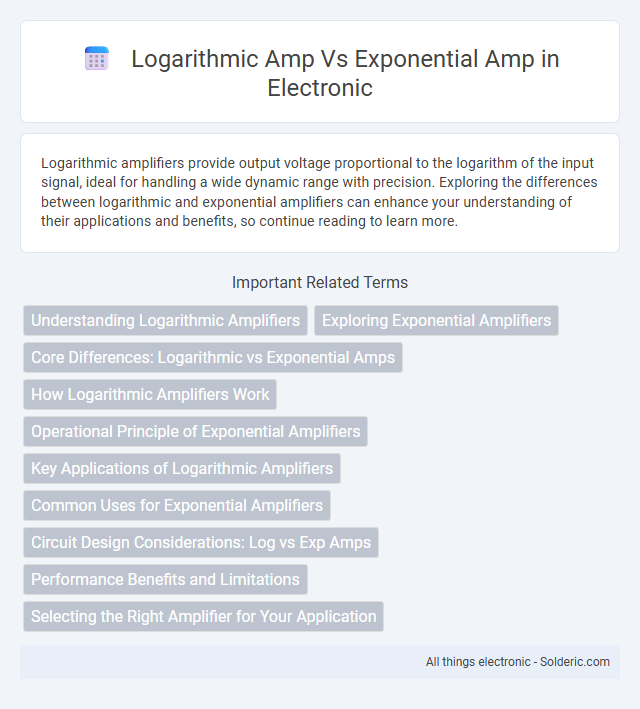Logarithmic amplifiers provide output voltage proportional to the logarithm of the input signal, ideal for handling a wide dynamic range with precision. Exploring the differences between logarithmic and exponential amplifiers can enhance your understanding of their applications and benefits, so continue reading to learn more.
Comparison Table
| Feature | Logarithmic Amplifier | Exponential Amplifier |
|---|---|---|
| Function | Output voltage log(input voltage) | Output voltage exp(input voltage) |
| Input-Output Relationship | Compresses dynamic range | Expands dynamic range |
| Common Uses | Signal compression, audio level detection, dynamic range control | Signal expansion, modulation, exponential signal generation |
| Linearity | Non-linear, logarithmic scale | Non-linear, exponential scale |
| Application Example | Automatic Gain Control (AGC) | Analog Multipliers/dividers |
| Key Component | BJT diode junction, diode-connected transistor | Transistors in exponential mode, op-amp circuits |
| Advantages | Wide input range, improves signal processing | Generates exponential outputs, useful for modulation |
| Disadvantages | Limited accuracy at low signals, temperature sensitive | Complex design, sensitive to device variations |
Understanding Logarithmic Amplifiers
Logarithmic amplifiers convert input signals into an output voltage proportional to the logarithm of the input amplitude, enabling accurate handling of signals with wide dynamic ranges. Unlike exponential amplifiers, which produce an output voltage exponentially related to the input, logarithmic amps excel in applications requiring precise measurement of signal intensity across multiple orders of magnitude. Understanding logarithmic amplifiers allows you to optimize circuits for audio processing, RF detection, and scientific instrumentation by leveraging their unique nonlinear transfer characteristics.
Exploring Exponential Amplifiers
Exponential amplifiers provide a nonlinear gain where the output voltage increases exponentially with the input signal, making them ideal for applications requiring a wide dynamic range such as audio processing and sensor signal conditioning. These amplifiers use transistor-based circuitry or operational transconductance amplifiers (OTA) to achieve the exponential transfer function, enabling precise control over logarithmic or exponential signal responses. Unlike logarithmic amplifiers that compress signal amplitude, exponential amplifiers expand the signal, enhancing sensitivity in measurement systems and improving modulation schemes in communication devices.
Core Differences: Logarithmic vs Exponential Amps
Logarithmic amplifiers increase output voltage in proportion to the logarithm of the input signal, making them ideal for handling wide dynamic ranges and compressing high-level signals without distortion. Exponential amplifiers, on the other hand, produce an output that grows exponentially with the input, useful in applications like analog signal processing where linearizing exponential sensor outputs is necessary. Understanding these core differences helps you choose the right amplifier type based on signal behavior and desired response characteristics.
How Logarithmic Amplifiers Work
Logarithmic amplifiers convert input voltage signals into output voltages proportional to the logarithm of the input, enabling precise handling of signals with wide dynamic ranges. They operate using components like transistors or operational amplifiers configured with negative feedback to achieve a logarithmic relationship. This functionality is essential in applications such as audio processing and signal compression, where accurate measurement of varying signal amplitudes is required.
Operational Principle of Exponential Amplifiers
Exponential amplifiers operate by producing an output voltage that is an exponential function of the input voltage, often utilizing the exponential current-voltage relationship of semiconductor devices like BJTs or diodes. The core principle involves exploiting the transistor's base-emitter junction to achieve logarithmic or exponential behavior, enabling precise analog signal processing in applications such as frequency modulation and waveform generation. Understanding the operational principle of exponential amplifiers allows you to design circuits that convert linear inputs into exponentially scaled outputs effectively.
Key Applications of Logarithmic Amplifiers
Logarithmic amplifiers are essential in applications requiring wide dynamic range measurements, such as audio signal processing, radar detection, and instrumentation for scientific measurements. These amplifiers convert multiplicative signal variations into additive outputs, enabling accurate analysis of signals with rapidly changing amplitudes. Your circuits benefit from their ability to handle signals ranging from microvolts to volts without distortion, making them ideal for communication systems and sensor signal conditioning.
Common Uses for Exponential Amplifiers
Exponential amplifiers are commonly used in audio applications for dynamic range compression, envelope shaping, and synthesizer circuits to create natural-sounding audio effects. These amplifiers are essential in voltage-controlled amplifiers (VCAs) and voltage-controlled filters (VCFs) where linear control needs to be translated into exponential responses for musical tone shaping. Their ability to provide precise control over signal amplitude makes them ideal for modulation and automatic gain control systems in signal processing.
Circuit Design Considerations: Log vs Exp Amps
Logarithmic amplifiers use diodes or transistors in their feedback loop to achieve a compression of input signals, making them ideal for applications requiring a wide dynamic range with reduced distortion. Exponential amplifiers, conversely, rely on transistor characteristics to produce outputs that increase exponentially with input voltage, demanding precise biasing and temperature compensation to maintain accuracy. Your choice between these amplifiers depends on the desired response curve and the complexity you can accommodate in circuit design and calibration.
Performance Benefits and Limitations
Logarithmic amplifiers provide superior dynamic range and better handling of wide-ranging input signals, making them ideal for applications requiring precise measurement of signals varying over several orders of magnitude. Exponential amplifiers excel in generating exponential relationships and are often used in analog computation and signal modulation but may suffer from limited linearity and increased distortion at extreme input levels. Your choice between these amplifiers depends on whether you prioritize measurement accuracy and wide dynamic range or specific exponential signal processing capabilities.
Selecting the Right Amplifier for Your Application
Choosing between a logarithmic amplifier and an exponential amplifier depends on your signal processing needs and dynamic range requirements. Logarithmic amplifiers are ideal for compressing wide-ranging signals, making them suitable for audio level detection and RF power measurement, whereas exponential amplifiers excel in applications requiring signal expansion or linearization, such as in certain sensor outputs. Understanding your input signal characteristics and output goals ensures you select the amplifier that optimizes performance and accuracy for your specific application.
Logarithmic amp vs Exponential amp Infographic

 solderic.com
solderic.com